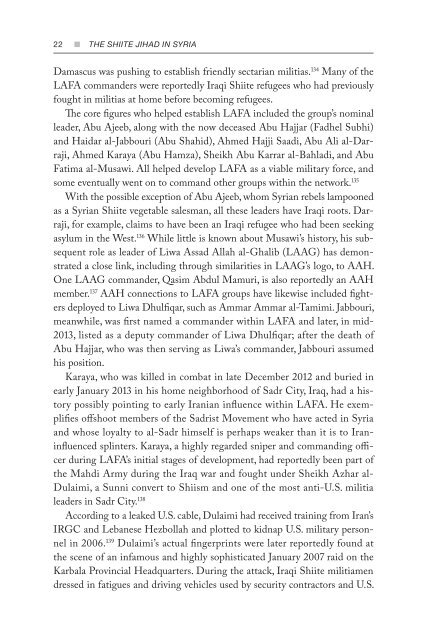You also want an ePaper? Increase the reach of your titles
YUMPU automatically turns print PDFs into web optimized ePapers that Google loves.
22 n <strong>THE</strong> <strong>SHIITE</strong> <strong>JIHAD</strong> <strong>IN</strong> <strong>SYRIA</strong><br />
Damascus was pushing to establish friendly sectarian militias. 134 Many of the<br />
LAFA commanders were reportedly Iraqi Shiite refugees who had previously<br />
fought in militias at home before becoming refugees.<br />
The core figures who helped establish LAFA included the group’s nominal<br />
leader, Abu Ajeeb, along with the now deceased Abu Hajjar (Fadhel Subhi)<br />
and Haidar al-Jabbouri (Abu Shahid), Ahmed Hajji Saadi, Abu Ali al-Darraji,<br />
Ahmed Karaya (Abu Hamza), Sheikh Abu Karrar al-Bahladi, and Abu<br />
Fatima al-Musawi. All helped develop LAFA as a viable military force, and<br />
some eventually went on to command other groups within the network. 135<br />
With the possible exception of Abu Ajeeb, whom Syrian rebels lampooned<br />
as a Syrian Shiite vegetable salesman, all these leaders have Iraqi roots. Darraji,<br />
for example, claims to have been an Iraqi refugee who had been seeking<br />
asylum in the West. 136 While little is known about Musawi’s history, his subsequent<br />
role as leader of Liwa Assad Allah al-Ghalib (LAAG) has demonstrated<br />
a close link, including through similarities in LAAG’s logo, to AAH.<br />
One LAAG commander, Qasim Abdul Mamuri, is also reportedly an AAH<br />
member. 137 AAH connections to LAFA groups have likewise included fighters<br />
deployed to Liwa Dhulfiqar, such as Ammar Ammar al-Tamimi. Jabbouri,<br />
meanwhile, was first named a commander within LAFA and later, in mid-<br />
2013, listed as a deputy commander of Liwa Dhulfiqar; after the death of<br />
Abu Hajjar, who was then serving as Liwa’s commander, Jabbouri assumed<br />
his position.<br />
Karaya, who was killed in combat in late December 2012 and buried in<br />
early January 2013 in his home neighborhood of Sadr City, Iraq, had a history<br />
possibly pointing to early Iranian influence within LAFA. He exemplifies<br />
offshoot members of the Sadrist Movement who have acted in Syria<br />
and whose loyalty to al-Sadr himself is perhaps weaker than it is to Iraninfluenced<br />
splinters. Karaya, a highly regarded sniper and commanding officer<br />
during LAFA’s initial stages of development, had reportedly been part of<br />
the Mahdi Army during the Iraq war and fought under Sheikh Azhar al-<br />
Dulaimi, a Sunni convert to Shiism and one of the most anti-U.S. militia<br />
leaders in Sadr City. 138<br />
According to a leaked U.S. cable, Dulaimi had received training from Iran’s<br />
IRGC and Lebanese Hezbollah and plotted to kidnap U.S. military personnel<br />
in 2006. 139 Dulaimi’s actual fingerprints were later reportedly found at<br />
the scene of an infamous and highly sophisticated January 2007 raid on the<br />
Karbala Provincial Headquarters. During the attack, Iraqi Shiite militiamen<br />
dressed in fatigues and driving vehicles used by security contractors and U.S.


